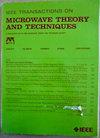XRL: An FMM-Accelerated SIE Simulator for Resistance and Inductance Extraction of Complicated 3-D Geometries
IF 4.1
1区 工程技术
Q2 ENGINEERING, ELECTRICAL & ELECTRONIC
IEEE Transactions on Microwave Theory and Techniques
Pub Date : 2024-10-02
DOI:10.1109/TMTT.2024.3465428
引用次数: 0
Abstract
A fast multipole method (FMM)-accelerated surface integral equation (SIE) simulator, called XRL, is proposed for broadband resistance/inductance (RL) extraction under the magneto-quasi-static (MQS) assumption. The proposed XRL has three key attributes that make it highly efficient and accurate for broadband RL extraction of complicated 3-D geometries: 1) the XRL leverages a novel centroid-midpoint (CM) basis transformation while discretizing surface currents, which allows converting edge-based vector potential computations to panel-based scalar potential computations. Such conversion makes the implementation of FMM straightforward and allows for drastically reducing the memory and computational time requirements of the simulator; 2) the XRL employs a highly accurate equivalent surface impedance (ESI) model that allows extracting RL parameters at low frequencies very accurately; and 3) the XRL makes use of a novel preconditioner, effectively including both diagonal entries and some near-field entries of the system matrix; such preconditioner significantly accelerates the iterative solution of SIE. The proposed XRL can accurately compute broadband RL parameters of arbitrarily shaped and large-scale structures on a desktop computer. It has been applied to RL parameter extraction of various practical structures, including two parallel square coils, a ball grid array (BGA) package, and a high brand package on package (HBPOP). Its application to the parameter extraction of the BGA shows that the XRL requires针对磁准静态(MQS)假设下的宽带电阻/电感(RL)提取,提出了一种名为 XRL 的快速多极法(FMM)-加速表面积分方程(SIE)模拟器。所提出的 XRL 具有三个关键属性,使其能够高效、准确地提取复杂三维几何结构的宽带电阻/电感:1)XRL 在对表面电流进行离散化处理时,利用了一种新颖的中心点-中间点(CM)基变换,从而将基于边缘的矢量电势计算转换为基于面板的标量电势计算。2) XRL 采用了高精度的等效表面阻抗(ESI)模型,可以非常精确地提取低频下的 RL 参数;以及 3) XRL 使用了新型预处理器,有效地包含了系统矩阵的对角线条目和一些近场条目;这种预处理器大大加快了 SIE 的迭代求解速度。所提出的 XRL 可以在台式计算机上精确计算任意形状和大规模结构的宽带 RL 参数。它已被应用于各种实际结构的 RL 参数提取,包括两个平行方形线圈、球栅阵列(BGA)封装和高品牌封装(HBPOP)。在BGA参数提取中的应用表明,与商业仿真器Ansys Q3D相比,在相同精度水平下,XRL所需的计算时间和内存资源分别减少了93.2倍和14.2倍。
本文章由计算机程序翻译,如有差异,请以英文原文为准。
求助全文
约1分钟内获得全文
求助全文
来源期刊

IEEE Transactions on Microwave Theory and Techniques
工程技术-工程:电子与电气
CiteScore
8.60
自引率
18.60%
发文量
486
审稿时长
6 months
期刊介绍:
The IEEE Transactions on Microwave Theory and Techniques focuses on that part of engineering and theory associated with microwave/millimeter-wave components, devices, circuits, and systems involving the generation, modulation, demodulation, control, transmission, and detection of microwave signals. This includes scientific, technical, and industrial, activities. Microwave theory and techniques relates to electromagnetic waves usually in the frequency region between a few MHz and a THz; other spectral regions and wave types are included within the scope of the Society whenever basic microwave theory and techniques can yield useful results. Generally, this occurs in the theory of wave propagation in structures with dimensions comparable to a wavelength, and in the related techniques for analysis and design.
 求助内容:
求助内容: 应助结果提醒方式:
应助结果提醒方式:


